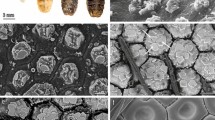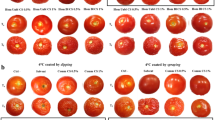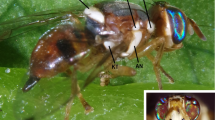Abstract
THE hardening of the protein of insect cuticles is due to the tanning action of an agent produced by oxidation of a phenolic substance1. The hardening of the cockroach ootheca. (Blatta orientalis) is analogous to this process, and we have recently demonstrated that the phenolic substance responsible in this case is 3 : 4-dihydroxybenzoic acid (I) (protocatechuic acid)2. Not only was this acid isolated in substantial quantity from the ootheca, but also it was found that an aqueous solution of synthetic protocatechuic acid in presence of oxygen produced the characteristic darkening effect of the secretion of the right colleterial gland of the female cockroach upon the protein secretion of the left gland. This study of the cockroach ootheca represented the initial phase of a more extensive investigation of the hardening process in insects; as a next step it was decided to attempt the isolation of phenolic substances from other species, to find out whether protocatechuic acid is a general hardening agent or whether the agent varies from species to species. The investigation is far from complete but, particularly in view of the general interest in the problem of the insect cuticle and the recent publications of Dennell3 and Fraenkel and Rudall4, it is felt that the results so far obtained are worthy of record at this stage. The species examined were Calliphora erythrocephala, Lucilia ccesar (puparia) and Tenebrio molitor (adults), and the experimental procedure and results can be summarized as follows.
This is a preview of subscription content, access via your institution
Access options
Subscribe to this journal
Receive 51 print issues and online access
$199.00 per year
only $3.90 per issue
Buy this article
- Purchase on Springer Link
- Instant access to full article PDF
Prices may be subject to local taxes which are calculated during checkout
Similar content being viewed by others
References
Pryor, Proc nm. Roy. Soc., B, 128, 378, 393 (1940).
Pryor, Russell and Todd, Biochem. J., 40, 627 (1946).
Dennell, Proc. Roy. Soc., B, 134, 79 (1947).
Fraenkel and Rudall, Proc. Roy. Soc., B, 134, 111 (1947).
Kropp and Decker, Ber., 42, 1186 (1909).
Kindler and Peschke, Arch. Pharm., 271, 431 (1933).
Oliviero, Gazz. chim., 65, 143 (1935).
Schmalfuss, Heider and Winkelmann, Biochem. Z., 257, 188 (1933).
Fischer and Schrader, Ber., 43, 525 (1910).
Private communication from Prof. D. Keilin.
Author information
Authors and Affiliations
Rights and permissions
About this article
Cite this article
PRYOR, M., RUSSELL, P. & TODD, A. Phenolic Substances Concerned in Hardening the Insect Cuticle. Nature 159, 399–400 (1947). https://doi.org/10.1038/159399a0
Issue Date:
DOI: https://doi.org/10.1038/159399a0
This article is cited by
-
Sclerotization and coloration of the insect cuticle
Experientia (1980)
-
N-Acetyl-dopamine as Sclerotizing Agent of the Insect Cuticle
Nature (1962)
-
Phenolic compounds and phenolases in arthropoda
Die Naturwissenschaften (1959)
-
Tanning of Blowfly Puparia
Nature (1955)
-
Succinic Acid in the Blood of theLarva of Gastrophilus intestinalis
Nature (1948)
Comments
By submitting a comment you agree to abide by our Terms and Community Guidelines. If you find something abusive or that does not comply with our terms or guidelines please flag it as inappropriate.



